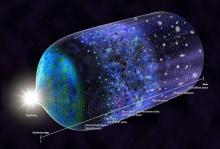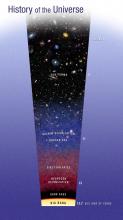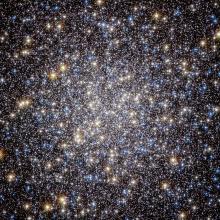Listen to today's episode of StarDate on the web the same day it airs in high-quality streaming audio without any extra ads or announcements. Choose a $8 one-month pass, or listen every day for a year for just $30.
You are here
Observable Universe
The universe might be infinitely large. And even if it’s not, it’s probably so big that it might as well be infinite. But we see only a tiny fraction of that extent — a bubble known as the observable universe.
What we see is limited by the speed of light — 670 million miles per hour. That’s fast. But it’s not infinite. So light can travel only so far in a year, or a century, or a billion years. Because the universe was born 13.8 billion years ago, we can’t see any farther than light can travel in that time — 13.8 billion light-years. The farthest galaxies and quasars that we’ve seen are almost that far away.
Or they were that far away. We see these objects as they looked at a distance of more than 13 billion light-years. But keep in mind that the universe is expanding. So today, there’s a lot more space between us and those early objects. In fact, today the edge of the observable universe is about 46 billion light-years away.
Assuming Earth were still around, in tens of billions of years, we’d see what those objects look like today. And the limits of the observable universe might eventually reach about 60 billion light-years. But the universe is expanding so fast that we’d never see any farther — limiting us to a bubble of space and time inside a possibly infinite universe.
We’ll have more about the observable universe tomorrow.
Script by Damond Benningfield






